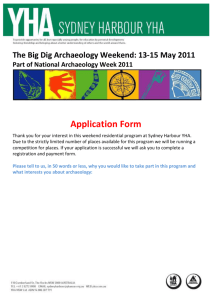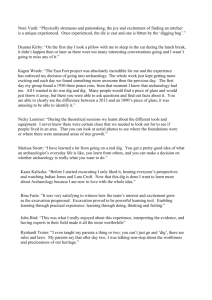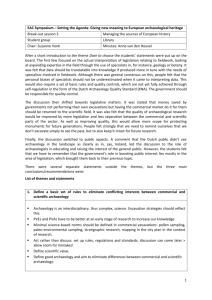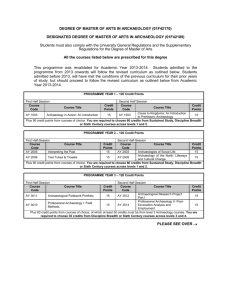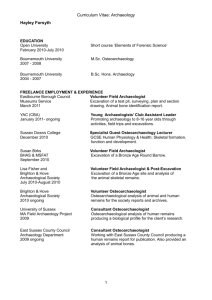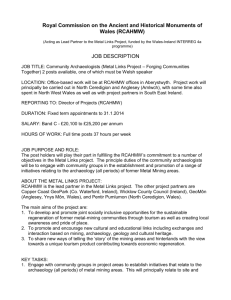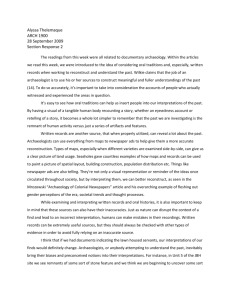Allison Barker Archaeology of College Hill October 31, 2011
advertisement
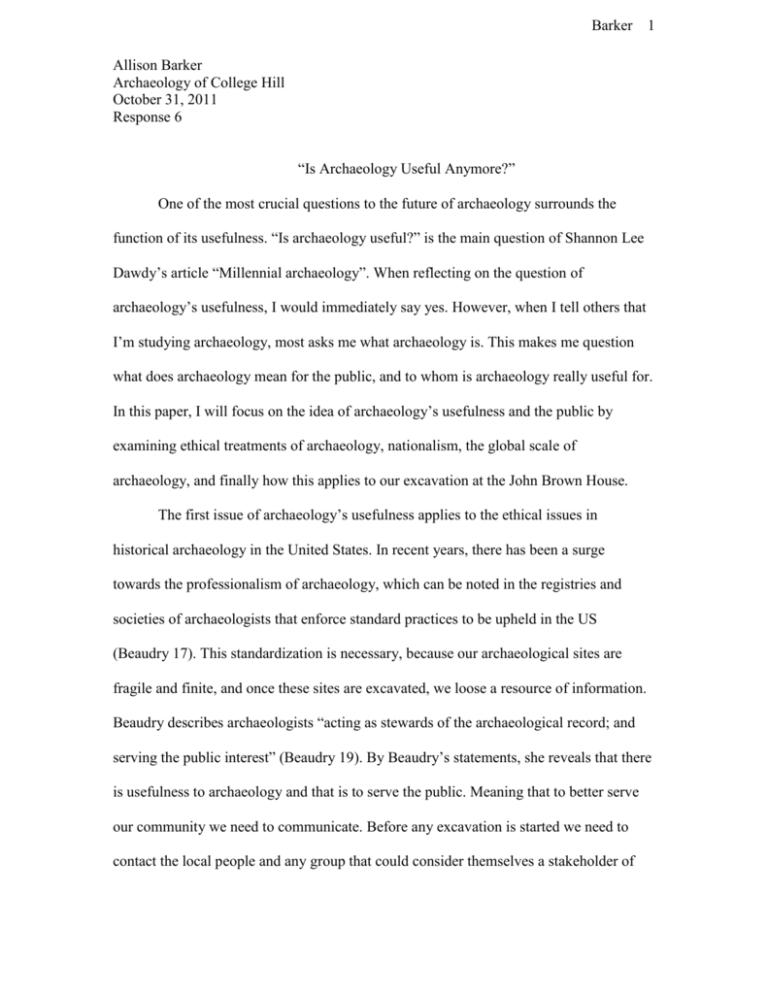
Barker 1 Allison Barker Archaeology of College Hill October 31, 2011 Response 6 “Is Archaeology Useful Anymore?” One of the most crucial questions to the future of archaeology surrounds the function of its usefulness. “Is archaeology useful?” is the main question of Shannon Lee Dawdy’s article “Millennial archaeology”. When reflecting on the question of archaeology’s usefulness, I would immediately say yes. However, when I tell others that I’m studying archaeology, most asks me what archaeology is. This makes me question what does archaeology mean for the public, and to whom is archaeology really useful for. In this paper, I will focus on the idea of archaeology’s usefulness and the public by examining ethical treatments of archaeology, nationalism, the global scale of archaeology, and finally how this applies to our excavation at the John Brown House. The first issue of archaeology’s usefulness applies to the ethical issues in historical archaeology in the United States. In recent years, there has been a surge towards the professionalism of archaeology, which can be noted in the registries and societies of archaeologists that enforce standard practices to be upheld in the US (Beaudry 17). This standardization is necessary, because our archaeological sites are fragile and finite, and once these sites are excavated, we loose a resource of information. Beaudry describes archaeologists “acting as stewards of the archaeological record; and serving the public interest” (Beaudry 19). By Beaudry’s statements, she reveals that there is usefulness to archaeology and that is to serve the public. Meaning that to better serve our community we need to communicate. Before any excavation is started we need to contact the local people and any group that could consider themselves a stakeholder of Barker 2 that site and see what their feeling are towards the excavation. We need to be sensitive to all stakeholders (Beaudry 21), because if our usefulness is for the public, then we would be doing the stakeholders a disservice and cease to be useful. If Beaudry is right, then how is archaeology useful on a national scale in the United States? First it is important to note that most of population came to America at the latest 500 years ago, comparatively to the 15,000 years Native American have inhabited the American continent (McManamon 131). Today, Americans still seem to believe that there was “no history” before Europeans came to the ‘New World’. Yet, we are still able to make a connection to the ancient past of this country through the idea of place (McManamon 131, 132). And this is all possible due the movement of archaeology, which started in the early 19th century, when the public became concerned with the preservation of places associated with the American Revolution (McManamon 118). Which in the late 19th century, moved into ideas to “explore, conserve, and preserve historical and natural resources”. These ideas were later linked with the “rise of American nationalism… and to the Progressive political movement” (McManamon 119). Therefore, it was with increased ‘cultural nationalism’ and a sense of ‘regional identity’ that allowed the “linkage of American nationalism with Native American history through archaeology” (McManamon 122). Which begs the question then, if archaeology was useful in the late to early 19th and 20th centuries, is it useful now? And the answer is that archaeologists need to strive to re-help the connection that Americans felt to American’s ancient past by providing opportunities for the public to become involved. However, this could be more problematic today, due to a surprising lack of nationalistic pride that most Americans, especially the younger generations, feel. Which leaves some archaeologist Barker 3 like Dawdy believe that historical archaeology is now irrelevant and not useful to the public (Dawdy 138). Then, is archaeology useful on a global scale? This can be answered through three forms of global archaeology. First, is the idea of world heritage monuments that are identified by agencies due to their “significance for all humanity” (Hodder 140). Second, is the idea of ‘diasporic processes’, where people feel a nostalgia for their homeland, and therefore become involved with the protection of their cultural heritage (Hodder 140,141). Third, is the idea of linking archaeology to “commercialism and leisure” (Hodder 141). Hodder says that ownership of the past is like sustainable tourism, in which no one owns the past or the environment. We can all “pass through”, but we also have a “responsibility to other passing through” (Hodder 142). Meaning that we need to look at both the international stakeholders of a site, as well as local stakeholders, like in the case of Catalhoyuk where conflicts have risen between the Goddess groups from California and local Islamic women (Hodder 142). Essentially, before any archaeological dig, we need to be aware that many people can feel ownership of a site, which makes us a have a “joint curatorial responsibility”. This stresses the point that archaeologists need to be aware of the different contexts of a site before excavation, and that there needs to be a surge of communication before we can ever “just dig” (Hodder 146). Which leads me to believe global excavation is useful to the public, if like stated above, communication is occurring to the stakeholders. Then, who are the stakeholders of the John Brown House? I believe the stakeholders are primarily Brown University, the Rhode Island Historical Society, which is linked to the John Brown House Museum, Rhode Islanders (due to the close ties of John Brown to the formation of Rhode Island as we know it), and Americans (for the Barker 4 foundation of America). But honestly, there are too many reasons for someone to feel connection to the John Brown House. Which is why it is crucial of us, as archaeologists, to connect to the public about this site. I feel we are able to accomplish this through our public weekly blogs about the excavation, our community field archaeology day, and our final excavation reports, which focus on the excavation, as well as, research questions relating to John Brown and his family. In conclusion, I feel that archaeology is still useful to the public both national, though Dawdy would disagree, and internationally. Archaeologists, through a movement of professionalism and public outcry, have come to realize that communication with stakeholders is one of the most important factors to excavations today. In fact, I do believe that archaeology will cease to be relevant and/ or useful the day that the connection between the archaeological world and the public is broken. Bibliography: Hodder, Ian. 2003. “Sustainable Time Travel: Toward a Global Politics of the Past.” In S. Kane, ed., The Politics of Archaeology and Identity in a Global Contest, 139-147. McManamon, Francis P. 2003. “Archaeology, Nationalism, and Ancient America.” In S. Kane, ed., The Politics of Archaelogy and Identity in a Global Contest, 115-138. Beaudry, Mary. 2009. "Ethical Issues in Historical Archaeology." In The International Handbook of Historical Archaeology, ed. by Teresita Majewski and David Gaimster. Springer, New York, 17-29 Dawdy, Shannon Lee. 2009 "Millennial Archaeology. Locating the Discipline in the Age of Insecurity." Archaeological Dialogues 16, no. 2 (2009): 131-‐ 42


